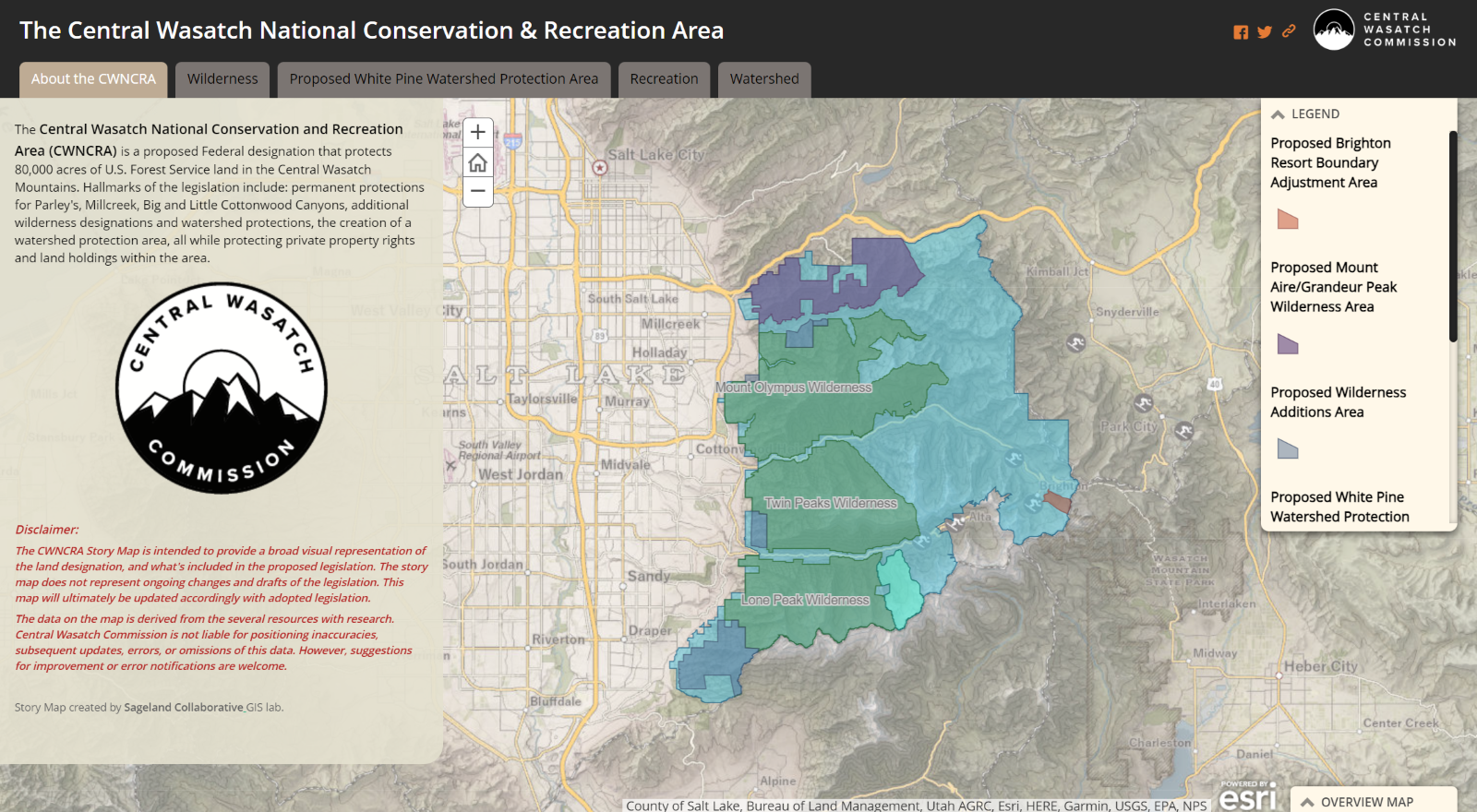The Original Central Wasatch National Conservation and Recreation Area Act
The CWNCRA is a locally driven, consensus-based bill aimed at protecting the sources of our drinking water, preserving recreational opportunities for the future, and ensuring enjoyment of the Central Wasatch Mountains in the face of pressures from a growing population.
Starting in 2013, representatives from local government, the Utah Governor’s office and state legislature, private business, environmental organizations and recreation interests, and residents worked together over the course of four years to reach consensus on a bill that aims to resolve decades of conflict over how the Central Wasatch mountains should be used and enjoyed. This Act is one outcome of the Mountain Accord – a local, public, and consensus-based process intended to influence regional planning and to enact meaningful conservation solutions for the Central Wasatch.
In 2016, Congressman Jason Chaffetz (R-UT) introduced bill H.R.5718, the Central Wasatch National Conservation and Recreation Area Act that proposed the creation of The Central Wasatch National Conservation and Recreation Area . The bill’s objectives were to balance the need to protect drinking water, preserve recreational opportunities and traditions, enhance access, and accommodate future population growth. National Conservation and Recreation area designations allow the force of law to direct the US Forest Service to manage the public lands contained within the designation in a certain way after careful review and public engagement.
The 112th Congress expired before the H.R.5718 could be presented to the floor, but stakeholders persisted by engaging the public for comment and have made changes to the legislation. The CWC staff and board are working with the Utah Federal Delegation to set a timeline for reintroduction of the legislation, with changes implemented.
10/27/20 – Central Wasatch National Conservation and Recreation Area Act Current Discussion Draft
Drafts of the legislation, including the most recent draft below, reflect proposed changes being considered. The CWC engages the public for comment and works with stakeholders to attempt to resolve components of the legislation in a consensus-based approach. Subsequent drafts of legislation will be made available for public review, and any action on draft legislation by the CWC will be noted accordingly.
The CWC opened a 30-day public comment period on the draft bill. The public comments may be read below.
To learn more about the details regarding the October 27, 2020 draft of the Central Wasatch National Conservation and Recreation Area Act, review the links below:
- 10/27/20 Draft CWNCRA Act
- 10/27/20 Draft CWNCRA Summary
- 10/27/20 CWNCRA map
- 10/27/20 public comments
- 10/27/20 Summary of Possible Legislative Changes
What Will the CWNCRA Do?
- Realignment of existing Wilderness to allow for the continued multi-use of the Bonneville Shoreline Trail
- The creation of a new Mount Aire/Grandeur Peak Wilderness Area
- An addition to the existing Lone Peak Wilderness Area
- The creation of the White Pine Watershed Protection Area
- Express authorization for the expansion or construction of parking areas, trailheads, or restrooms within the NCRA if a need is identified
- Direction for the creation of a management plan for the NCRA within 3 years after the adoption of the bill that must:
- Protect water quality and watershed resources
- Protect environmentally sensitive areas
- Manage natural resources
- Promote public safety, including avalanche control
- Facilitate year-round outdoor recreation
- Private lands have no overlay of a new designation. Additionally, the ski permit areas where resort skiing is permitted by the Forest Service are not within the NCRA boundary
- The CWNCRA does not affect the ability of authorized users to access, operate, and maintain water infrastructure within the NCRA with applicable authorizations and permits
- Mechanized travel is not prohibited in the NCRA. It is prohibited in wilderness and the White Pine Watershed Protection Area. Fire maintenance, fuels reduction, vegetation management, and other public safety measures including avalanche control are explicitly allowed for within the NCRA
- The Transportation Section of the legislation states explicitly that the designation does not prohibit “transportation improvements and associated public amenities, including roadway improvements, public transportation, mountain transportation systems, transit stops, stations, trailheads, bike lanes, restrooms, and pedestrian infrastructure.”
CWNCRA Drafts and Public Comments
- Original CWNCRA (introduced to Congress in 2016) H.R. 5718 and 7/7/16 Map and 7.7.16 Land Exchange Map
- 7/6/18 CWC Summary Matrix draft
- 7/17/18 CWNCRA Draft and 7.6.18 public comment matrix
- 8/2/18 CWNCRA Draft
- 7/9/18 – 8/2/18 Public Comments and Responses
- 8/19 – 9/19 CWNCRA Comments
- Guide to CWNCRA 8/19/19 Draft
- 10/26/18 Draft CWNCRA
- 10/26/18 Summary of CWNCRA Act
- 10/26/18 CWNCRA Map
- 11/28/18 Chronology of Efforts to Address Alta Ski Lifts
- 8/19/19 CWNCRA Draft
- 8/19/19 CWNCRA Guide
- 8/19/19 Land Exchange Map
- 11/1/19 CWNCRA Act working draft
- Appendix of comments
- Legislative changes for draft CWNCRA
- CWNCRA Federal Designation Map
- CWNCRA Land Exchange Map
- Central Wasatch NCRA revised map
Mechanical transportation and devices are prohibited in Wilderness areas, as dictated by the Wilderness Act of 1964; however, the Act specifically addresses mechanical treatment as it relates to fire suppression and mitigation: “Mechanical treatment and prescribed fire may be utilized within wilderness where consistent with the Wilderness Act and agency regulations, as when necessary to protect public safety.” (FSM 2323.52). This means that where mechanical transportation and tools like mountain bikes chainsaws are prohibited in Wilderness, in the case for fire suppression and management, mechanical treatment would be allowed.
For more information, see the Wildfire and Wilderness Primer paper written and released by the Wilderness Society.

 Click on the image to view the interactive CWNCRA map.
Click on the image to view the interactive CWNCRA map.